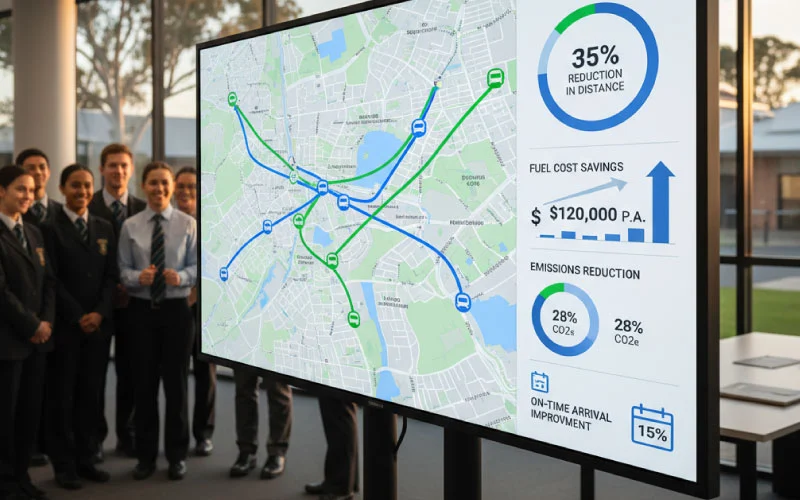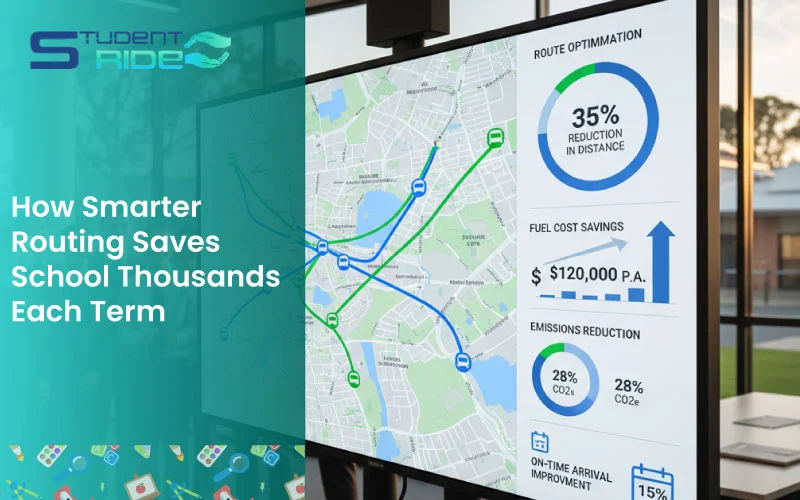Why Smarter Routing Matters
Every Australian school understands the pressure of balancing budgets. Staff salaries, facility upgrades, and learning resources often take priority, leaving school transport as an overlooked cost centre. But here’s the reality:
- Inefficient bus routing can drain thousands of dollars every single term.
- Poor planning leads to extra admin workload for school staff.
- Wasted kilometres increase fuel costs, driver overtime, and maintenance expenses.
Meanwhile, parents expect safety, punctuality, and transparency. Schools that fail to modernise their transport operations risk not just money, but also trust and reputation.
That’s where smarter routing and platforms like StudentRide come in. They’re designed to save schools money, reduce admin headaches, and provide a seamless experience for families.
The Cost of Inefficiency in School Transport
Hidden Financial Leaks in Every Trip
When schools rely on manual spreadsheets and outdated scheduling, they lose money in small but repeated ways:
- Fuel Wastage
- Even an extra 5 km per route adds up to thousands annually.
- With fuel prices in Australia averaging around $2 per litre, schools overspend unnecessarily.
- Even an extra 5 km per route adds up to thousands annually.
- Driver Overtime
- Poorly planned routes often result in late arrivals and extra pay.
- Overtime is not just costly—it risks breaching compliance rules.
- Poorly planned routes often result in late arrivals and extra pay.
- Vehicle Maintenance
- Extra mileage = faster wear and tear.
- Tyres, brakes, and servicing costs rise dramatically with inefficient routing.
- Extra mileage = faster wear and tear.
- Administration Hours
- Staff spend hours juggling parent calls, transport spreadsheets, and compliance forms.
- This diverts valuable time away from core responsibilities like curriculum and student well-being.
- Staff spend hours juggling parent calls, transport spreadsheets, and compliance forms.
What is Smarter Routing?
Smarter routing is more than plotting bus stops on Google Maps. It’s an intelligent, AI-powered system that:
- Analyses student addresses and clusters them into efficient zones.
- Considers traffic data, roadworks, and travel patterns.
- Adjusts dynamically when a student is absent or a bus is full.
- Integrates with a school transport dashboard to provide real-time visibility.
Think of it as a transport control tower for schools—one that not only reduces costs but also keeps parents informed and students safe.

How Smarter Routing Saves Schools Thousands
1. Cutting Kilometres = Cutting Costs
- A medium-sized school with 10 buses can save up to $20,000 per year by eliminating unnecessary kilometres.
- Smarter routing reduces overlaps, ensuring every kilometre is justified.
2. Full Buses, Fewer Trips
- Running half-empty buses is one of the biggest cost drains.
- Smarter routing consolidates routes to maximise seating capacity.
3. Admin Time Saved
- School administrators reclaim 10–15 hours per week when dashboards automate communication with parents.
- That’s equivalent to $15,000–$25,000 in annual saved labour costs.
4. Predictable Budgets
- With smarter dashboards, schools can forecast transport costs more accurately.
- This predictability makes financial planning easier for boards and bursars.
Case Studies: Real-World Savings
Case Study 1: Independent School, Victoria
- Fleet: 12 buses
- Problem: Overlapping routes, half-empty buses, excessive admin workload
- Solution: Implemented StudentRide routing & dashboards
- Result:
- Saved $14,000 in Term 1
- Reduced admin hours by 60%
- Parents praised live tracking for peace of mind
- Saved $14,000 in Term 1
Case Study 2: Catholic College, New South Wales
- Fleet: 8 buses
- Problem: Overtime claims from drivers, parent complaints about delays
- Solution: Smarter routing adjusted departure and arrival sequences
- Result:
- Saved $10,500 per year in overtime
- Cut average commute times by 18%
- Parents reported higher satisfaction in the annual survey
- Saved $10,500 per year in overtime
Case Study 3: Private Grammar School, Queensland
- Fleet: 15 buses
- Problem: Carbon-conscious families are concerned about emissions
- Solution: Smarter routing reduced unnecessary kilometres by 12%
- Result:
- Carbon footprint reduced by 18 tonnes CO₂ annually
- School featured sustainability efforts in marketing campaigns
- Boosted enrolment appeal to eco-minded parents
- Carbon footprint reduced by 18 tonnes CO₂ annually
Benchmarking: What Inefficiency Really Costs Schools
Let’s compare two schools with similar fleets:
Metric | Traditional Routing | Smarter Routing (StudentRide) |
Annual Fuel Spend | $85,000 | $68,000 |
Driver Overtime | $12,000 | $2,500 |
Vehicle Maintenance | $25,000 | $18,000 |
Admin Hours (per year) | 700 hrs | 250 hrs |
Total Cost | $122,000 | $88,500 |
Savings: $33,500 annually—per school.
How Smarter Routing Reduces Admin Workload
One of the most overlooked benefits is the time saved for administrators.
- Before StudentRide: Staff manually chase parents, reassign drivers, and update spreadsheets.
- After StudentRide:
- Automatic SMS/email updates for parents
- Instant compliance reporting
- Dashboard showing student attendance, routes, and bus status
- Automatic SMS/email updates for parents
This shift reduces stress and frees administrators to focus on education.
Parents’ Perspective
Parents are often the loudest voices when transport goes wrong. Smarter routing addresses their concerns:
- Transparency: Live GPS tracking shows exactly where buses are.
- Safety: Alerts confirm when children board or leave the bus.
- Punctuality: Optimised routes reduce delays.
When schools adopt smarter transport, parents gain confidence—and schools gain a stronger reputation.
Sustainability: An Added Bonus
Australia’s education sector is under pressure to demonstrate sustainability commitments. Smarter routing helps schools:
- Reduce carbon emissions through fewer kilometres.
- Participate in green transport programs.
- Report sustainability metrics to parents and boards.
This is not just cost-saving—it’s brand-enhancing.
Expanded FAQ Section
Q1. How quickly can a school see savings with smarter routing?
Most schools see measurable savings in the first term after implementation.
Q2. Do we need to hire new staff to manage the dashboard?
No. The system is designed to reduce admin workload, not add to it. Staff usually save time.
Q3. Will parents accept the change?
Absolutely. Parents welcome live tracking, fewer delays, and better communication.
Q4. How does this integrate with compliance checks?
StudentRide automatically records driver details, route times, and attendance logs for audit-ready compliance.
Q5. Is this suitable for both small and large schools?
Yes. From 2 buses to 50 buses, smarter routing scales effortlessly.
